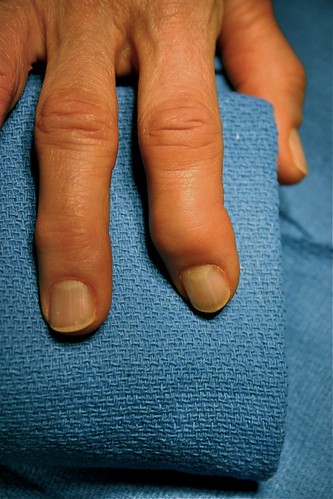If I Have Surgery for Trigger Thumb Will I Have the Problem Again Later on
Trigger Finger Surgery Recovery
Trigger finger is a painful, inconvenient condition that surgeons can resolve hands. If bourgeois treatment has failed in the by, information technology might exist time to motility forward and try something new. Fortunately, a quick and minor outpatient process can provide you lot with consummate relief of your symptoms. What is trigger finger, and how do you treat it?
What Is Trigger Finger?

Image via Flickr past handarmdoc
Trigger finger, or flexor tenosynovitis, is a condition where inflammation causes thickening of the flexor tendon in the finger, which then causes nodules to course. The inflammation and nodules go far difficult for the tendon to laissez passer through the sheath surrounding it. Sometimes, the tendon sheath thickens as well, causing a narrow passageway. Trigger finger occurs when the flexor tendon gets and remains stuck in a bent position as you're trying to straighten your finger. This condition tin can bear upon any finger, including the thumb.
While trigger finger has no known cause, doctors have linked information technology to several chance factors. For example, it'southward more probable to touch females than males and occurs more often in individuals who are middle-aged or take diabetes. Other risk factors include a history of inflammatory diseases or repetitive motion injuries.
What Are the Mutual Symptoms of Trigger Finger?
The easiest and nigh common way to place trigger finger is observing how the finger reacts when you bend or straighten it. The affected fingers or thumb typically snap closed and stick in that position. Yous might experience pain and swelling in the finger or even a lump near a joint. Sometimes, y'all might need to extend the finger manually. In more astringent cases, the finger can become locked in the bent position.
Trigger finger symptoms tend to worsen in the morning and ease throughout the day as the finger relaxes. If yous're experiencing any of these symptoms, schedule a consultation with your physician. You tin as well try these trigger finger exercises to help with the hurting. More severe cases might demand treatment with a single outpatient surgery. At The Paw and Wrist Constitute, you'll be treated by a team of highly skilled professionals dedicated to providing you with quality care and an answer to your issues. Nosotros'll show you how to prepare for your surgery, what to expect earlier, during, and after surgery, and how to perform surgery aftercare and rehabilitation exercises.
What Happens During Trigger Finger Surgery?
Surgeons perform trigger finger procedures in an outpatient setting, and you can expect to return domicile after. You'll receive anesthesia before your surgery so you can remain yet for a more than constructive result. The practitioner makes a pocket-sized incision into the palm during the procedure and opens the tightened sheath. This simple surgery allows the area to heal with actress room so the finger tin can move normally. The surgeon sutures the site and applies a small dressing, which must stay in place for about x days.
What Is Recovery Similar After Surgery?
Later trigger finger surgery, you might feel minor swelling and soreness for several days. You might as well accept difficulty moving the finger initially, simply this will ameliorate in a few weeks. You might experience slight numbness or tingling near the incision site — this sensation will improve over time as well. After near a week, yous will come in for a post-op engagement, at which point the doctor will remove your sutures and dressing. Full healing time is about half dozen weeks, later on which most patients can resume regular activity.
You might exist able to return to work within a few days if your job doesn't require repetitive use of the affected manus, just if you're required to do whatever heavy lifting, have to use pressure to the hand, or perform repetitive movements, you might need upward to six weeks off piece of work. Dr. Knight can tell you when information technology's appropriate to resume normal activities when y'all come in for your follow-upwards appointment.
At-Domicile Care
After surgery, have the following steps to ensure a smooth healing process:
- Become plenty of rest . If you're feeling tired, that's a sign your trunk needs residue to recover.
- Stay active . Get-go with a low-impact practise, such as walking, each day.
- Rest the mitt. Avoid using your mitt for lifting, typing, washing, vacuuming, or other repetitive movements.
- Resume activities. You can shower, but avoid taking baths until the doctor removes your bandage and sutures.
- Consume a balanced diet . If you're experiencing nausea, yous might attempt a bland diet for the first few days after your procedure.
- Continue with medications. If you're on blood thinners or take Aspirin, ask when it's safe to resume them after your surgery.
- Keep it covered. Get out your cast on until you're instructed to remove information technology. Keep the area clean and dry.
- Ease into movement. You tin can bend and straighten your fingers gently a few times throughout the 24-hour interval to help reduce swelling and keep them flexible. You might need physical therapy to regain full range of motion and force in your hand. Once yous're fully recovered, you'll still want to have preventative measures when exercising to continue from reinjuring yourself.
Proper follow-up care is key for a successful recovery. Be sure to go to all your follow-up appointments equally directed and call the office if yous have any issues or questions.
Things To Watch For
If y'all have any of the following side effects, it's important to telephone call the office and tell them what you're experiencing:
- You lot observe loose sutures, or your incision has come open.
- Y'all're bleeding through the cast over the incision site.
- You lot develop a fever.
- You lot have increased swelling, pain, redness, or warmth at the surgery site.
- You lot have astringent numbness or tingling in your mitt or fingers.
- You cannot move your fingers.
- Your fingers are cool to the bear on or begin to change color.
While some of these can be signs of infection, they all indicate you're not healing equally desired and should seek additional and immediate care.
Contact The Mitt and Wrist Establish Today
If yous've been suffering from the symptoms of trigger finger and want to schedule an appointment to discuss surgery, accomplish out to our Dallas-surface area offices today. Dr. Knight and his squad will become over handling options and help yous get back to a pain-free life. You tin can reach us by telephone at 817-382-6789 or contact u.s. online through our convenient messaging organization.
Source: https://handandwristinstitute.com/trigger-finger-surgery-recovery/

0 Response to "If I Have Surgery for Trigger Thumb Will I Have the Problem Again Later on"
Post a Comment